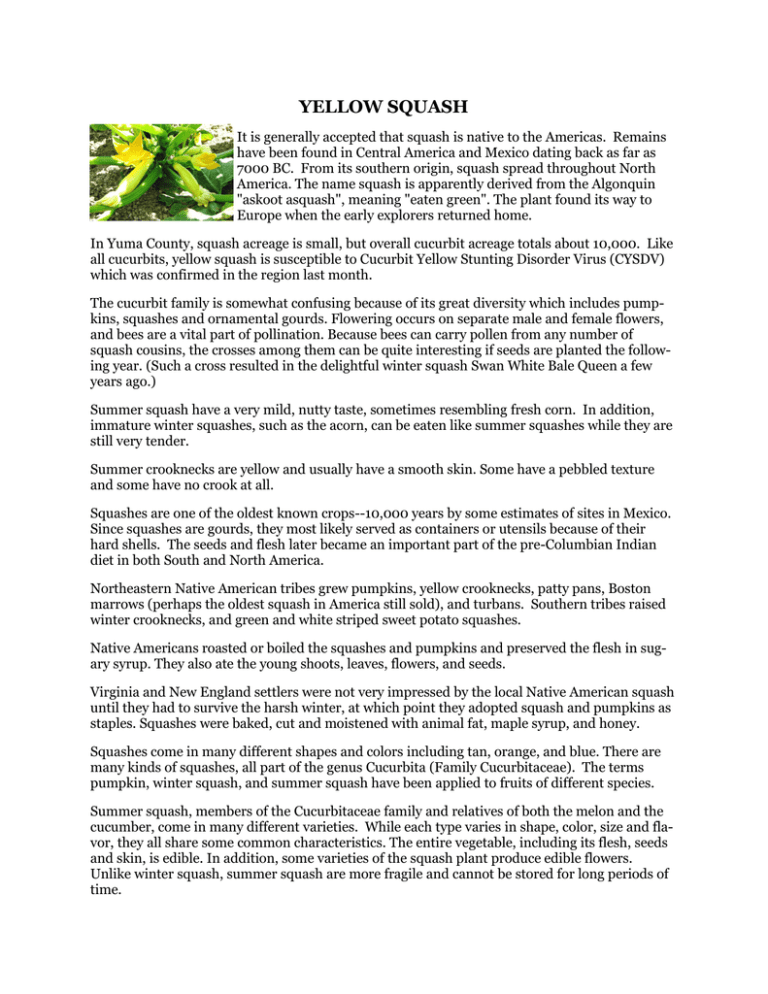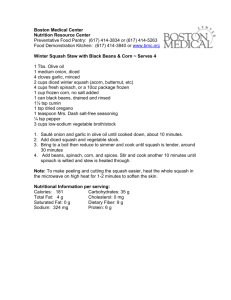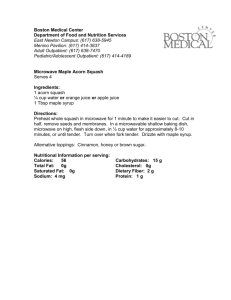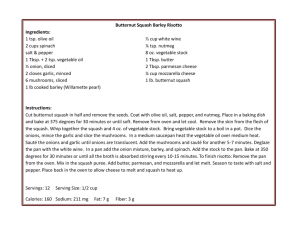YELLOW SQUASH
advertisement

YELLOW SQUASH It is generally accepted that squash is native to the Americas. Remains have been found in Central America and Mexico dating back as far as 7000 BC. From its southern origin, squash spread throughout North America. The name squash is apparently derived from the Algonquin "askoot asquash", meaning "eaten green". The plant found its way to Europe when the early explorers returned home. In Yuma County, squash acreage is small, but overall cucurbit acreage totals about 10,000. Like all cucurbits, yellow squash is susceptible to Cucurbit Yellow Stunting Disorder Virus (CYSDV) which was confirmed in the region last month. The cucurbit family is somewhat confusing because of its great diversity which includes pumpkins, squashes and ornamental gourds. Flowering occurs on separate male and female flowers, and bees are a vital part of pollination. Because bees can carry pollen from any number of squash cousins, the crosses among them can be quite interesting if seeds are planted the following year. (Such a cross resulted in the delightful winter squash Swan White Bale Queen a few years ago.) Summer squash have a very mild, nutty taste, sometimes resembling fresh corn. In addition, immature winter squashes, such as the acorn, can be eaten like summer squashes while they are still very tender. Summer crooknecks are yellow and usually have a smooth skin. Some have a pebbled texture and some have no crook at all. Squashes are one of the oldest known crops--10,000 years by some estimates of sites in Mexico. Since squashes are gourds, they most likely served as containers or utensils because of their hard shells. The seeds and flesh later became an important part of the pre-Columbian Indian diet in both South and North America. Northeastern Native American tribes grew pumpkins, yellow crooknecks, patty pans, Boston marrows (perhaps the oldest squash in America still sold), and turbans. Southern tribes raised winter crooknecks, and green and white striped sweet potato squashes. Native Americans roasted or boiled the squashes and pumpkins and preserved the flesh in sugary syrup. They also ate the young shoots, leaves, flowers, and seeds. Virginia and New England settlers were not very impressed by the local Native American squash until they had to survive the harsh winter, at which point they adopted squash and pumpkins as staples. Squashes were baked, cut and moistened with animal fat, maple syrup, and honey. Squashes come in many different shapes and colors including tan, orange, and blue. There are many kinds of squashes, all part of the genus Cucurbita (Family Cucurbitaceae). The terms pumpkin, winter squash, and summer squash have been applied to fruits of different species. Summer squash, members of the Cucurbitaceae family and relatives of both the melon and the cucumber, come in many different varieties. While each type varies in shape, color, size and flavor, they all share some common characteristics. The entire vegetable, including its flesh, seeds and skin, is edible. In addition, some varieties of the squash plant produce edible flowers. Unlike winter squash, summer squash are more fragile and cannot be stored for long periods of time. Although not as potent as root-like vegetables like garlic or onion, squashes have been found to have anti-cancer type effects. Although phytonutrient research on squash is limited, some lab studies have shown vegetable juices obtained from squash to be parallel to juices made from leeks, pumpkin, and radish in their ability to prevent cell mutations (cancer-like changes). Crookneck and Straightneck Squash: Both of these summer squashes have creamy white flesh and generally have yellow skins, although sometimes you can find them with green skin. Crookneck squash is partially straight with a swan-like neck. It was genetically altered to produce its straightneck cousin that is shaped as its name implies. Modern day squash developed from the wild squash that originated in an area between Guatemala and Mexico. While squash has been consumed for over 10,000 years, they were first cultivated specifically for their seeds since earlier squashes did not contain much flesh and what they did contain was very bitter and unpalatable. As time progressed, squash cultivation spread throughout the Americas, and varieties with a greater quantity of sweeter-tasting flesh were developed. Christopher Columbus brought squash back to Europe from the New World, and like other Native American foods, their cultivation was introduced throughout the world by Portuguese and Spanish explorers. Today, the largest commercial producers of squash include China, Japan, Romania, Turkey, Italy, Egypt, and Argentina. The term "summer" and "winter" for squash are only based on current usage, not on actuality. "Summer" types are on the market all winter; and "winter" types are on the markets in the late summer and fall, as well as winter. Thus, the terms "summer" and "winter" are deceptive and confusing. This terminology was never meant to confuse— it just dates back to a time when the seasons were more crucial to man's survival than they are now. "Good keepers" became known as winter vegetables if they would "keep" until December. Less than thirty years ago, the summer squash, often referred to as Italian squash, was hardly recognized in the United States. Today, it is not only widely-recognized, but a particular favorite of home gardeners. Notwithstanding its prolific growing nature, its popularity is probably due to in large part to its versatility as a vegetable as well as in breads and desserts. Although the term summer squash can mean a variety of different squashes depending on to whom you are speaking, you can pretty much use the different summer squash varieties interchangeably. When purchasing summer squash, select those that are heavy for their size and with a shiny, unblemished skin. Additionally, the rinds should not be very hard since this indicates that the squash are over mature and will have hard seeds and stringy flesh. Purchase summer squash that are of average size since those that are overly large may be fibrous, while those that are overly small may be inferior in flavor. Summer squash is very fragile and should be handled with care as small punctures will lead to decay. It should be stored unwashed in a plastic bag in the refrigerator, where it will keep for about seven days. While it can be frozen, this will make the flesh much softer. To do so, blanch slices of summer squash for two minutes before freezing. Kurt Nolte is an area agriculture agent with the Yuma County Cooperative Extension. He can be reached at 928-726-3904.



